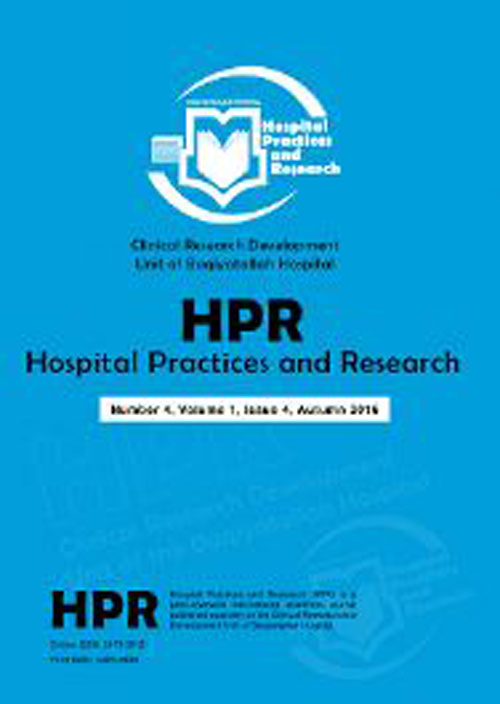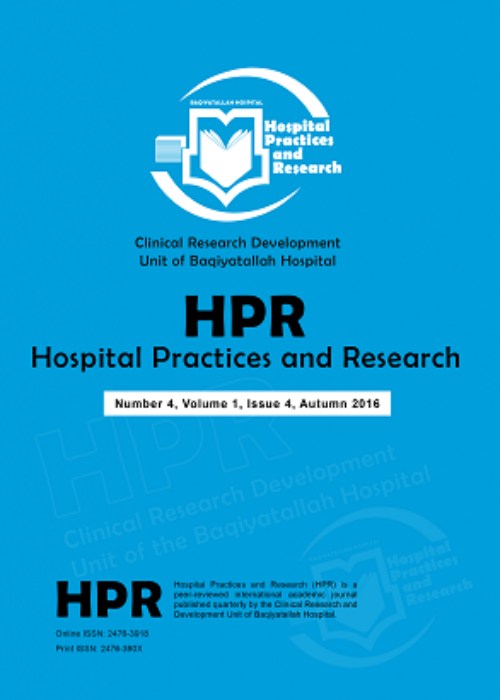فهرست مطالب

Hospital Practices and Research
Volume:6 Issue: 2, Spring 2021
- تاریخ انتشار: 1400/04/27
- تعداد عناوین: 8
-
-
Pages 42-50Background
Coronavirus disease 2019 (COVID-19) has become a global challenge to the health care system. A novel agent to combat this deadly virus is still a matter of research. Herbal molecules have served humanity since the beginning.
ObjectivesThis narrative review aims to study the antiviral properties of medicinal plants, which are already effectively used in the past against various viruses. It derives the importance of exploration of such phytochemicals, which can be complementarily used to treat COVID-19.
MethodsStudies related to traditional medicine and treatment for viruses were retrieved from databases including PubMed, Google scholar until December 2020 using the keywords SARS-CoV-2, COVID-19, Immunological, Phyto-chemicals, Traditional Medicine. The resulting publications were analyzed to develop a narrative review on the traditional Indian phytochemicals that have been shown to effectively treat various viral infections and potentially treat or prevent COVID-19.
ResultsMany of the researches are showing that Indian herbal compounds have a significant potential against viral diseases. Plants like Azadirachta indica, Withania somnifera, Tinospora cordifolia, Ocimum basilicum, and many more have been shown tremendous antiviral, anti-inflammatory, and immune-modulatory activities.
ConclusionPhytochemicals obtained from the herbs can be helpful in the treatment and prevention of SARS-CoV-2via various modes such as inhibition of attachment, penetration, uncoating, replication, assembly, and release of respiratory viruses. Further analysis of the potential phytochemicals in treating SARS-CoV-2 in clinical trials is warranted.
Keywords: SARS-CoV-2, COVID-19, Immunological, Phyto-chemicals, traditional medicine -
Pages 51-58Background
The lack of specialist physicians is a major concern in developing countries, especially in deprived cities.
ObjectivesThis study aimed to identify the predictive variables of the turnover intention of physicians working in an undeveloped and deprived city in Iran.
MethodsParticipants were 100 physicians working at North Khorasan University of Medical Sciences, Iran. The data were collected using a standard questionnaire of Turnover Intention, Interpersonal Conflict, Work-Family Conflict, Work Overload, and Organizational Support scales. We proposed a hybrid methodology to identify factors influencing turnover intention, which combines clustering and classification methods. RStudio 1.1, SPSS Clementine 12, and SPSS 22 programs were used for data analysis. After data clustering, we made a CART decision tree model for each cluster and used the variable importance feature of SPSS Clementine to discover the factors influencing turnover intention in each cluster.
ResultsWe found two significant clusters of physicians’ turnover intention. In both clusters, interpersonal conflict (work ambiguity and work conflict) was the most important predictor of physician turnover intention, but physicians in the first cluster compared to the second had a higher turnover intention. In cluster 1, work overload, organizational support, and work-family conflict were respectively the predictors of physician turnover intention and in cluster 2, organizational support, work-family conflict, and final work overload were respectively the predictors of physician turnover intention.
ConclusionCultural differences and the resulting interpersonal conflicts are the most important predictors of physician turnover intention in deprived areas. Turnover intention predictions of physicians with a longer work experience are different from that of others, and human resource managers must implement appropriate strategies to keep physicians in the deprived areas.
Keywords: turnover intention, Work Ambiguity, Work Conflict, organizational support, work-family conflict, Work Overload -
Pages 59-64Background
Provision of quality and accessible health services comes with its challenges. Therefore, the need to highlight how motivation and job satisfaction can impact nurses’ performances at the Korle-Bu teaching hospital.
ObjectivesThe research aimed to practically highlight nurses’ motivation and job satisfaction by identifying what constituted motivation packages of nurses and how the work they did could give them satisfaction at the Korle-Bu teaching hospital.
MethodsThe research employed a qualitative method with a case study design. In-depth interviews and focus group discussions (data triangulation) were used for primary data collection. A total of 40 respondents, including ten key informants, were selected using the purposive and convenience sampling techniques.
ResultsThe research found that the recognition of needs of nurses, improved remunerations, enhanced conditions of service of the nurses’, regular payment of nurses’ salaries’, the institution of study leave with pay policy, among others, were considered as factors that could contribute to nurses’ motivation and job satisfaction. These findings are consistent with the findings of other studies. Again, the study found that professional allowances paid to nurses, reduced rent, and the like are current motivation packages directed at nurses at the Korle-Bu teaching hospital.
ConclusionIt is important to state that for motivation to accomplish its intended purpose, there is the need for the hospital to identify the individual needs to satisfy to enhance job satisfaction.
Keywords: Motivation, Job Satisfaction, Remuneration, Salaries, Fringe Benefits, Hospitals, Health Services -
Pages 65-70Background
Endotracheal intubation (EI) associated with mechanical ventilation (MV) is frequently performed in critically ill patients admitted to intensive care unit (ICU) with sepsis.
ObjectivesThis study aimed to assess the impact of important factors on the duration of tracheal intubation in patients with sepsis at the ICU admission.
MethodsAdult patients admitted to the mixed medical–surgical ICUs with sepsis at the ICU admission who needs prolonged mechanical ventilation (PMV) (≥ 21 days) were included in this retrospective secondary analysis study. The primary outcome was ICU mortality. Baseline demographic and clinical characteristics of all patients were assessed as risk factors associated with the duration of MV by univariate and multivariate Binary logistic regression.
ResultsEighty-five patients required more than 21 days of MV. Out of the 85 patients, 52 (61.2%) patients were intubated within 30 to 34.50 days and 33 (38.8%) patients had intubation within 34.51 to 65 days, and categorized as PMV and very prolonged MV groups, respectively. Two parameters were significantly associated with very prolonged MV which are as follows: older age 1.229 (95% CI: 1.002-1.507, P = 0.048) and long hospital stay (LOS) 2.996 (95% CI: 1.676-5.356, P < 0.001). No significant survival difference was observed between the two groups of study. (33.3% vs. 25%, P = 0.406).
ConclusionOur observations showed that the older age and LOS as pre-ICU stay in patients with positive sepsis at the ICU admission can prolong the duration of intubation. In addition, no significant survival difference was observed between patients with PMV and very prolonged MV.
Keywords: Sepsis, Intensive Care Unit, Endotracheal Intubation, Prolonged Mechanical Ventilation -
Identifying the Factors Affecting the Management of Addiction Treatment Clinics: A Qualitative StudyPages 71-74Background
Due to the expansion of addiction treatment clinics and the costs that these clinics incur on the government and the families of addicts, monitoring the performance of these clinics and the need to pay attention to the principles of management, efficiency, and effectiveness is essential.
ObjectivesThe present study was conducted to identify the factors affecting the management of addiction treatment clinics.
MethodsThe present study is a descriptive-applied and cross-sectional study conducted in 2019. Experts and academic experts have been considered as the research community, and 18 people were selected as the research sample by the purposeful snowball method. Data collection tools were the review of relevant national and international documents as well as semi-structured exploratory interviews. Finally, after collecting information from the interview sections and reviewing the sources, the data foundation and coding methods (open, axial, and selective) were used to classify the data.
ResultsThe findings of the study showed that the effective factors in the management of addiction treatment clinics are dimensions such as organization, planning, control, guidance as well as leadership and treatment management.
ConclusionAccording to the findings of this study, it can be concluded that the effective factors in the management of addiction treatment clinics can be a good basis to evaluate managers so that the policies and programs of the organization can be upgraded, modified, and reviewed.
Keywords: Clinical Management, Addiction Cessation, Treatment Management -
Pages 75-79Background
Poor teaching and lack of proper relations between teacher and student and various other causes affect students’ academic burnout.
ObjectivesPresent study was conducted to determine the relationship between educational justice and academic burnout in medical interns of Ahvaz Jundishapur University of Medical Sciences, Ahvaz, Iran.
MethodsThis study was descriptive and analytical. The number of samples was equal to 300 medical interns identified and entered by the census sampling method. Data were completed by two questionnaires (researcher-made educational justice and burnout standard) whose reliability and validity were confirmed. Data were analyzed by SPSS Version 22.
ResultsThere was no significant relationship between educational justice and academic burnout (P>0.05). Also, educational justice was below average and academic burnout was above average. There was a significant relationship between educational justice score and gender (P < 0.05), and there was no critical relationship with other demographic variables (P>0.05). There was no significant relationship between academic burnout score and all demographic variables (P>0.05).
ConclusionThis study concluded that causes other than educational justice have been influential on students’ academic burnout. Hence, it suggested that studies be conducted on high academic burnout and identify influential variables. On the other hand, although the relationship between the two variables was not significant, due to the low level of educational justice, the university’s need for fair educational opportunities, especially professors, should be considered.
Keywords: Educational Justice, Academic burnout, Medical Interns -
Pages 80-82Inrtoduction
Granulomatosis with polyangiitis (GPA) is a systematic and necrotizing vasculitis with positive autoimmune antibodies. Some studies have reported the prevalence of eye involvement between 40%-50% of cases. Retro orbital granuloma is a rare complication of GPA which should be treated by surgical involvements, while pachymeningitis can be diagnosed by MRI and treated by medical management. In this study, we tried to present a case of GPA with optic neuritis and typical central nervous system (CNS) involvement, while there were no definite features of sinusitis or kidney injuries.
Case PresentationA 15-year-old girl was admitted because of blurred vision in her left eye. She was a known case of GPA three years ago with initial features, including left facial nerve paresis due to pan-sinusitis and pulmonary cavity. Neurologic evaluations, including sensory and motor features, were normal, too. Ophthalmologic examinations showed that visual acuity of the right eye was good, while the visual acuity in the left eye decreased to the point of finger counting at a distance of 20 cm. The left eye Marcus gunn test was positive (3+); anterior and posterior eye segments were normal. The patient was evaluated by brain MRI with gadolinium and a pathologic enhancement in the left cavernous was seen which had a pressure effect on the optic nerve. She was treated by intravenous methylprednisolone followed by rituximab.
ConclusionReporting orbital mass in a patient who had GPA can be supposed as granuloma which needs a biopsy to confirm a diagnosis. In our case, the imaging manifestation was heterodox for granuloma, while neurosurgical consultation recommended drug treatment for pachymeningitis.
Keywords: GPA, Pachymeningitis, Granuloma, Orbit


